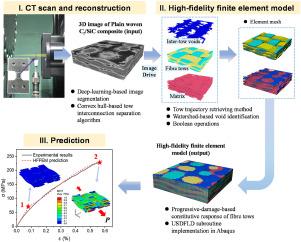基于深度学习的编织陶瓷基复合材料图像驱动建模:结合真实孔隙形态和损伤诱导行为
IF 14.2
1区 材料科学
Q1 ENGINEERING, MULTIDISCIPLINARY
引用次数: 0
摘要
提出了一种基于图像驱动的编织陶瓷基复合材料高保真有限元模型生成方法。该模型结合了纤维束、基质和纤维束间空隙的真实形态。利用高分辨率x射线CT扫描平纹编织Cf/SiC复合材料,采用基于深度学习的图像分割方法,从CT图像中准确分割纤维束。一种基于凸壳的算法,以及一种彻底的拖曳轨迹跟踪方法,被开发用于处理纤维拖曳相交,并在分割图像中对纤维拖曳的横截面进行分类。针对空洞识别问题,提出了一种基于分水岭变换的快速空洞识别方法。所得到的几何模型与材料的3D CT图像具有高度的形态保真度。此外,建立了纤维束的渐进损伤非线性应力-应变关系,并将其纳入CT图像驱动的有限元模型。预测的应力-应变曲线与实验结果具有良好的相关性,与理想模型相比具有更高的精度,从而更准确地反映了应力分布。本文章由计算机程序翻译,如有差异,请以英文原文为准。

Deep-learning-based image-driven modelling of woven ceramic matrix composites: incorporating real void morphology and damage-induced behaviour
An image-driven method for generating high-fidelity finite element models for woven ceramic matrix composites is presented in this paper. The model incorporates the real morphologies of fibre tows, matrix, and inter-tow voids. With high-resolution X-ray CT scans of plain woven Cf/SiC composites, a deep-learning-based image segmentation method was employed to accurately segment the fibre tows from the CT images. A convex hull-based algorithm, alongside a thorough tow trajectory tracking method, was developed to handle fibre tow intersections and categorise the cross-sections of the fibre tows in the segmented images. For void identification, a rapid approach based on the watershed transform was implemented. The resulting geometric model demonstrates a high degree of morphological fidelity with the 3D CT image of the material. Furthermore, a progressive damage-induced nonlinear stress-strain relation for fibre tows was developed and incorporated into the CT image-driven finite element model. The predicted stress-strain curve has excellent correlations with experimental results, demonstrating higher accuracy compared to the ideal model, and therefore more accurately reflects the stress distributions.
求助全文
通过发布文献求助,成功后即可免费获取论文全文。
去求助
来源期刊

Composites Part B: Engineering
工程技术-材料科学:复合
CiteScore
24.40
自引率
11.50%
发文量
784
审稿时长
21 days
期刊介绍:
Composites Part B: Engineering is a journal that publishes impactful research of high quality on composite materials. This research is supported by fundamental mechanics and materials science and engineering approaches. The targeted research can cover a wide range of length scales, ranging from nano to micro and meso, and even to the full product and structure level. The journal specifically focuses on engineering applications that involve high performance composites. These applications can range from low volume and high cost to high volume and low cost composite development.
The main goal of the journal is to provide a platform for the prompt publication of original and high quality research. The emphasis is on design, development, modeling, validation, and manufacturing of engineering details and concepts. The journal welcomes both basic research papers and proposals for review articles. Authors are encouraged to address challenges across various application areas. These areas include, but are not limited to, aerospace, automotive, and other surface transportation. The journal also covers energy-related applications, with a focus on renewable energy. Other application areas include infrastructure, off-shore and maritime projects, health care technology, and recreational products.
 求助内容:
求助内容: 应助结果提醒方式:
应助结果提醒方式:


